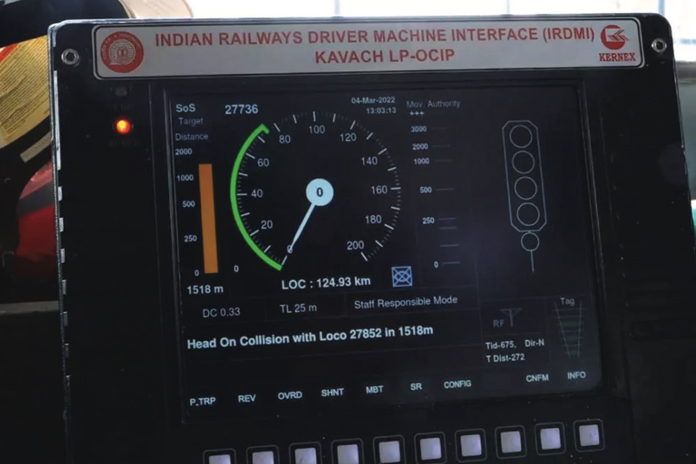The recent railway accident in West Bengal in which a goods train collided into the Kanchanjungha Express, leaving 10 dead and 40 injured, has once again raised questions over the delay in installing the indigenously developed anti-collision train protection device Kavach.
It’s been four years since Indian Railways began deploying the device, yet only 1,465 route km (Rkm), or 2 per cent of the country’s 68,000-Rkm railway network has been covered so far. About 139 locomotives, belonging to the South Central Railway zone, have been installed with the safety device.
In a social media post, Sudhanshu Mani, a former Indian Railways officer who is believed to be the force behind the launch of the Vande Bharat express trains, said the incident underscored the need for a speedier rollout of Kavach, which, he stressed, “would have surely prevented this tragedy”.
“No time for blame game or ‘I told you so’ but it is disappointing that IR (Indian Railways) is again trying to get away with lame excuses like ‘industry’s capacity’. Own it up…” the retired officer wrote.
After the first field trials of Kavach in February 2016, three firms — Kernex, HBL Systems, and Medha — were selected in 2018-19 for the manufacture and supply of the device.
Manufacturing hitch
Senior railway officials have frequently attributed the slow rollout of Kavach to the capacity constraints of the existing vendors, and the lengthy process for on-boarding new ones.
At least two vendors, including Quadrant (with which RailTel has signed a memorandum of understanding), are awaiting clearance. A few more original equipment manufacturers (OEMs) are expected to be onboarded through upcoming tenders. The complexities involved include the need to customise the device for each train.
How Kavach works
Officials explain that several moving parts of the Kavach system need to be synced across data centres, tracks, and locomotives. It must also be synced in accordance with train speed and weight, and the type of train — namely goods or passenger carrying.
Kavach broadly comprises a stationary control unit or station unit, a radio unit, and an array of passive radio frequency identifier (RFID) tags positioned at station and block sections.
The onboard equipment comprises a brake interface, a computer connected to a speed sensor, RFID reader, radio unit, and display unit. The onboard RFID reader is mounted on the under-frame of a locomotive in order to read the RFID tags fitted between rails and collect data such as the unique tag ID, direction of travel, unique track identification number, and so on. This data is communicated to the station unit through the radio link.
The station unit locates the train and sends information such as the approaching signal, which the onboard equipment uses in tandem with the train speed detected through sensors mounted on the loco axle to determine whether it is within a safe speed limit.
If the locomotive is running beyond the safe speed limit, an alert is sounded to the loco pilot for five seconds before initiating the brakes and bringing the train to a complete stop.
Installation timeline
By the end of the year, Kavach is expected to cover the 3,000-km Delhi–Howrah route, one of the busiest for Indian Railways. The 1,531 Rkm main line and 1,432 Rkm Grand Chord line will together cover four major railway zones — Eastern, East-Central, Northern, and North-Central.
In a 2022 report, North Central Railway had stated that a majority of train accidents resulting from ‘signal passing at danger’ or overshooting a stop signal was due to human error, including momentary loss of concentration.
Indian Railways reports, on average, 50 cases of ‘signal passing at danger’ a year (2016 to March 2021). “In response to the continuing need to reduce risks… an ATP (automatic train protection) system has been envisaged,” it said.
“The preparation of detailed estimates is underway for another 6,000 Rkm, including the Delhi–Mumbai and Delhi–Guwahati routes,” a senior railway ministry official has said.
Tenders for Kavach
The other railway zones have also ordered surveys for Kavach installation.
The Northeast Frontier Railway (NFR) had in May announced that Kavach will be installed along 2,000 Rkm (of its 4,416-Rkm network) between Dibrugarh (Assam) and Maldah Town (West Bengal).
Southern Railway plans to cover 2,216 Rkm. “Installation will be in phases, with priority for Vande Bharat routes,” a ministry official said. North-Western Railway — covering Rajasthan, Haryana, Punjab and Gujarat — plans to cover 1,600 Rkm by 2025.
Western Railway will install along 735 Rkm, including the 336 Rkm Virar–Surat–Vadodara line, 303 Rkm Vadodara–Ratlam–Nagda line, and 96 Rkm Vadodara–Ahmedabad segment. Around 90 locomotives are expected to have Kavach installed this year.










